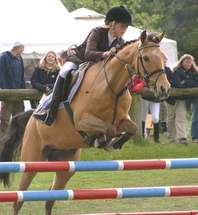Show jumping is one of the most popular horse events around the world and takes place in many different countries. It is just one member of a family of equestrian riding events including dressage, eventing, hunters and equitation. So, we have decided to fill you in on the history of show jumping whilst also giving you a number of great beginner’s tips to the sport.
History of show jumping
Show jumping was born in Paris in 1866 when the first class for show jumpers began and it it didn’t make its way to England for another 15 years. When it first arrived on our shores it was known as a Lepping competition.
Horses show jumping became more popular in the 1900s when show jumping was included in more important horse shows. There were separate classes for men and women where they could ride side saddle. Horses were, of course, jumping long before horse shows and when the forward seat was developed riders learnt how to aid horses in clearing obstacles.
It was the Italian, Captain Caprilli, who worked out a natural method of riding by watching horses jumping at liberty. Captain Caprilli’s teachings were thorough and revolutionary in the show jumping world and still dominate the teachings of the event today. Caprilli suggested that by leaving the horse’s head and neck unconstrained it would enable the horse’s back to be relieved of the rider’s weight; this would stop the rider from impairing the horse’s balance while show jumping.
Grand Prix show jumping also originated in France and in 1912 it was introduced to the Olympic Games. The rules of show jumping were standardised between countries so that riders from across the world could potentially compete in a horse jumping show. It was England in 1907 that the first International Horse Show was formed. Surprisingly enough it wasn’t until fairly recently in 1965 that the first Grand Prix took place in the USA.
The sport of show jumping is exciting, it is a combined struggle to conquer faults and time. It is an extreme physical effort for both horse and rider who both have to have an athletic sense of balance. Both the horse and rider have to have a connection where they can read each others thoughts before every jump. The horse and rider can’t see what is the other side of the wall, the obstacles are high, broad or sometimes narrow. Some fences are double or even triple and nothing can be dislodged or touched.
The horse and rider have to have courage, physical ability and intelligence to be successful at show jumping. The horse has to have extremely powerful muscles in the hindquarters to provide the necessary spring and a long extended stride. If a horse is to land after jumps of heights above six foot then the horse’s legs have to be sound and the hooves carefully looked after.
Finding the right sort of horse for show jumping is important. A horse must have a fighting spirit to prepare him for a horse jumping show and be able to judge obstacles wisely. The horse’s nerves have to be made of steel and his reactions lighting speed. No two Grand Prix courses are built the same, the rider can walk the course but the horse is only allowed to see the course once before his big moment. Obstacles must be taken in a certain sequence and you want to aim for no faults and a fast time.
Some tips for beginners
Carry out some research. Try not to rush into things, even if you’re desperate to start exploring show jumping opportunities. Taking the time to consider your options may actually enhance your chances of long term success with the sport.
-
First of all, make a list of all the competitions in your area and find out entry requirements and eligibility. This will give you something to aim for within a set time period when it comes to planning horse showjumping training.
-
Naturally, your first few steps in the world of equestrian jumping may be a little daunting – especially when it comes to negotiating horse jumps for the first time.
However, it’s important to remember that even leading Olympic show jumpers will have experienced a knock to their confidence at one stage or another – whether from a fall or from incurring penalties. Therefore, persevere and keep practising, even if some training sessions leave you feeling exasperated.
-
Seek expert advice in the early stages – this will really help you to work on technique. Often, jumping style can be improved significantly with a couple of minor adjustments to technique.
A show jumping instructor can also help you to cut out forced errors, and although you may have some initial misgivings as to whether equestrian showjumping is the right discipline for you, honing your skills with an advanced show jumper will help you to gain confidence and more importantly good judgement when it comes to clearing horse jumps.
-
Build up your experience step-to-step, even if it takes time. Remember, it’s best to take your time and perfect your jumping style rather than attempting to fast-track training to reach competition standard. Iron out all the minor flaws in your jumping style before you even begin to think about competition.
Even if the horse is a prolific jumper, it will still be relying on your guidance, so take things slow and start with small horse jumps. Approach the jump at your own pace – remember, speed isn’t everything in early showjumping.
-
Finally, once you have managed to master the basics, it’s important not to get complacent. This sport requires complete dedication, and you will only make an impact at competition if you show real commitment to refining your talent. It’s always a challenge to clear horse jumps, and horses will need constant conditioning to ensure they are fit for show jumping.
So, there you have it, the history of show jumping explained and some great tips for beginners. If you have any tips of your own then why not write them in the comment section below? It is always good to pass on your wisdom to fellow horse lovers.



